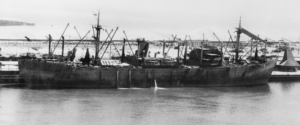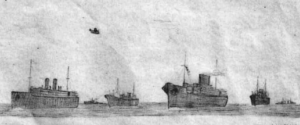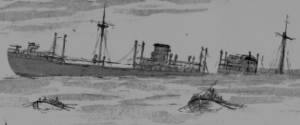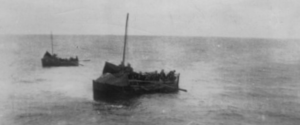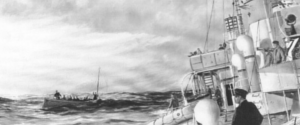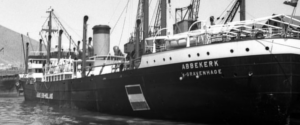Unplanned and unwanted: contact with convoy ON(S)122

23 August 1942
On August 22 a submarine was reported by radio, which was on our projected route about 500 miles ahead. On August 24 at 08:15 ships time a position was recieved of a submarine on August 23 at 23:00 GMT. This one was at the given GMT about 65 miles from our position at 08:15 on 24/8.
Official report of the sinking of Abbekerk by Captain Wijker
Determining your location in the middle of the ocean is difficult. Knowing the enemy may be listening in, different tactics are used to make sure ships are at their destined location without the enemy knowing. Abbekerk sails the ocean following pre defined points. In all communications those points are referenced to and not the real coordinates. On August 23th Abbekerk sails towards ‘point J‘. The real coordinates of these points are communicated to Abbekerk before she left and will never be mentioned over the radio. If Abbekerk states her location it looks like this: 150 miles southwest of point J. And if she receives an order to change course because the Admiralty expects a U-boat to be crossing her path she receives orders e.g. to change course to a point 80 miles south of point H.

Part of the German ‘Grossquadrate’ (Grid) map. The smallest square itself was diveded again in 9 parts. (Source: german-navy.de)
The Germans came up with their own way of determining their location. They divided the ocean in rectangles and those rectangles again in smaller squares and so on. So a position like CA2745 meant a 6×6 miles area, accurate enough and quickly transmitted.
Ships time: All times used here are referenced to Abbekerks 'ships time' unless stated differently.
Abbekerk at 14:00
On August 24 during the afternoon watch, directly after recieving the previously mentioned message, a convoy came in sight dead ahead. We immediately altered cours 90 degrees to starboard to keep as much distance as possible of the convoy. One of her escorting corvettes came to us to make sure of our identity and approached as close as half a mile. After she positively identified us gave the messages: “Submarines are known in the vicinity”.
Since no new course was recieved, nor by the Admirality, neither by the commander of the corvette, and since the last reported submarine position was by now ten hours old, we proceded on our original heading.
Official report of the sinking of Abbekerk by Captain Wijker
This was convoy ON(S)122 which all ready had had multiple confrontations with tailing U-boats of the wolfpack Lohs in the last few days, but at that point had not lost a ship. The corvette was the Norwegian HnoMS Eglantine.
Encountering a convoy is something a merchant ship sailing independent wants to prevent at all cost. The vast (and especially empty) ocean is her biggest protection. The proverbial needle in the haystack. A convoy on the other hand is a magnet for U-boats which will circle the convoy searching for ways to attack. An unprotected lone vessel showing up is an easy prey. Most likely Captain Wijker was familiar with the destruction of MS Almkerk also a VNS ship a year earlier. She was also a fast ship sailing independent but sailed in to a convoy under attack near the Cape Verde Islands. Still in sight of the convoy Almkerk was torpedoed and sunk.
Abbekerk sails away as fast as she can, but as it turns out to no avail.
U-604 at 14:52

Sketch from U-604’s daily positions. The bottom left on the map she encoutered Abbekerk.
(Source: www.uboatarchive.net)
U-604 as part of the Lohs wolfpack has been looking for convoy ON(S)122 for days. Less then an hour after Abbekerk loses sight of the convoy KtLt Holtring writes the following in his war diary:
14:52 While hunting for the convoy a large 12000 ton freighter in sight directly ahead, bow right, target angle 90°. With hard to port turned off and put astern. Then came to the determined general course of 360°. Both diesels ahead AK.
Steamer makes large legs around general course 20° with zig zags to both sides of 20-90°. At first the bearing is steady, after 30 minutes bearing begins to decrease.
Decision: Because of the low speed advantage pursuit continued, because steamer is in sight, while the convoy location is still uncertain.
KTB U-604 by KtLt Holtring

